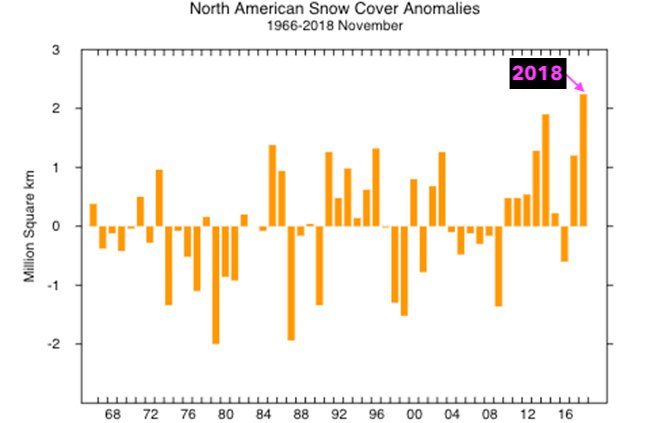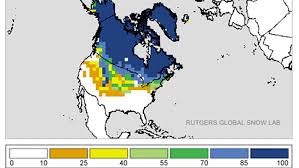
Last November's average snow cover across North America was an estimated 5.24 million square miles, topping the previous November record of 5.11 million square miles in 2014, according to data from the Rutgers University Global Snow Lab (GSL) dating to 1966.
This extent of snow cover was about 861,000 square miles larger than average, over three times the size of Texas.

Persistent cold from the Northeast to the Plains to the northern and western Gulf Coast and a number of expansive winter storms gave this winter weather season a fast start, driven by a persistent southward nosedive of the jet stream.
"This permitted arctic air to plunge into a good portion of Canada, and subsequently the U.S., leading to early-season snowfall and also remaining cold enough for the snow cover to become established for the season in northerly locales," said Rutgers University professor and New Jersey state climatologist David Robinson in an email to weather.com.
"This early cover, in turn, helped to refrigerate air masses moving across the snow-covered ground, further enhancing the cold."
By the end of the month, every U.S. state except Florida had picked up at least a trace of snow in autumn.
In mid-November, Winter Storm Avery squeezed out the earliest-in-season flakes of snow on record at Houston's Bush Intercontinental Airport, then proceeded to smash the earliest measurable snowfall on record in Monroe, Louisiana, Nov. 14 before dumping the second-heaviest November calendar-day snowfall on New York City.
That was followed by Winter Storm Bruce at the end of the Thanksgiving holiday weekend, a rare November blizzard in parts of the Plains and Midwest.
Dozens of cities from Maine to Kansas to Texas and the Deep South had one of the 10 coldest Novembers on record, according to the Southeast Regional Climate Center. It was the coldest November dating to 1888 in Kansas City.
For the entire northern hemisphere, the GSL found it was the third-most-expansive November snow cover in their 53-year database, topped only in 1993 and 1985.
North America also had its second-most-expansive October snow cover in 2018 - topped only in 2002 - and a record September snow cover extent.
"While snow was late to arrive in Alaska, it came on early across a good portion of Canada beginning in September and moving through October," said Robinson, adding that Canada set snow cover records in September, October and November.
"It's striking to see that in the past decade, every single autumn month has seen greater-than-average North American snow cover except for Sept. 2011, Sept. 2012, Oct. 2011, Nov. 2009 and Nov. 2016," said Bob Henson, meteorologist at Category 6 blogger at Weather Underground.
"That's just 5 out of 30 months."
What this means for the rest of winter remains uncertain.
While December could trend less cold, particularly across the northern tier of the U.S., the core winter months of January and February might trend colder than average, particularly in the East and Southeast.
Robinson said the key is where the polar jet stream plunges, and how often, compared to a flatter jet stream pattern: "Likely, all of these situations will be seen at some point along the way, the question being which one(s) predominates, thus dictating what the primary temperature regime will be in various regions of the U.S. and Canada.
We made corrections to the article to remove Greenland from the North America snow cover areas and anomalies.



Reader Comments